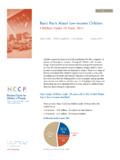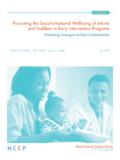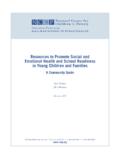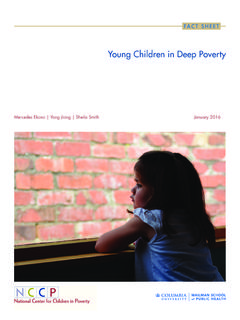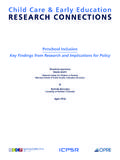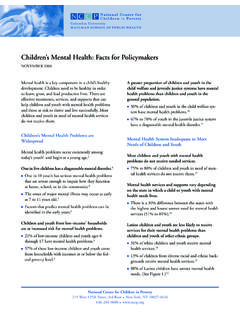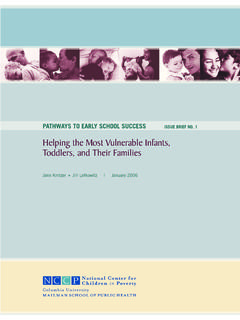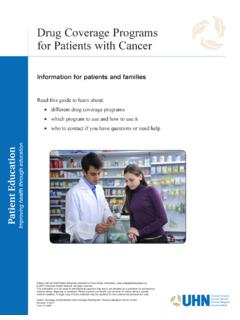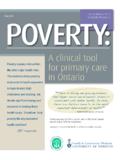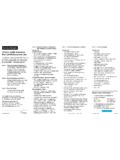Transcription of Depression and Low-Income Women: Challenges in …
1 Depression AND Low-Income women : Challenges FOR TANF AND WELFARE-TO-WORK POLICIES AND PROGRAMS Mary Clare Lennon Juliana Blome Kevin English April 2001 Research Forum on Children, Families and the New Federalism National Center for Children in Poverty Mailman School of Public Health Columbia University ACKNOWLEDGEMENTS Support for the development of this report has come from the Center for Mental Health Services (CMHS) of the Substance Abuse and Mental Health Services Administration (SAMSHA)of the Department of Health and Human Services. We are grateful to Judith Katz-Leavy of CMHS for her encouragement and support in the development of this report. We are also thankful to Barbara B. Blum, Jane Knitzer, John Lanigan, Susan Mayer, Deborah Phillips and Cybele Raver for helpful comments on earlier drafts of this paper. Beth Hair, Marty Zaslow and S. K. Ahluwalia of Child Trends provided support by analyzing the data from the National Evaluation of Welfare to Work Strategies that are presented in this report.
2 CONTENTS INTRODUCTION 1 THE POLICY CONTEXT 1 Depression AND ITS SYMPTOMS 2 ASSESSMENT OF Depression 3 PREVALENCE OF Depression IN THE POPULATION 4 Depression and Socioeconomic Status 4 MAJOR Depression AND DEPRESSIVE SYMPTOMS IN women ON WELFARE 5 Studies of major depressive disorder 5 Studies of depressive symptoms 7 EMPLOYMENT: ITS RELATION TO Depression 9 Depression as a Barrier to Employment 9 Depression as a Barrier to Job Retention 10 Depression as Result of Job Characteristics 11 Depression as a Result of Unemployment 11 THE TROUBLING CONSEQUENCES OF MATERNAL Depression FOR CHILDREN 12 Pathways of Influence 13 Methodological Issues Limiting Generalizations 14 TREATMENT OF Depression 14 Guidelines for the Treatment of Depression 14 Treatment Efficacy 15 ALTERNATIVE INTERVENTIONS 17 TREATMENT IN THE GENERAL POPULATION 18 DISPARITIES IN THE TREATMENT OF Depression 18 CARE RECEIVED ONCE ACCESS HAS BEEN ACHIEVED 20 BARRIERS TO TREATMENT 20 Institutional Barriers 21 Provider Barriers 22 Patient Barriers 23 SCREENING AND ASSESSMENT.
3 IMPLICATIONS FOR TANF AND WELFARE-TO WORK PROGRAMS 23 Screening Tools 24 Revealing Personal Information 24 Confidentiality 25 Diagnostic Assessment 25 Delivery of Services 25 System Changes 25 RESEARCH ISSUES 25 POLICY ISSUES 27 REFERENCES 29 LIST OF FIGURES AND TABLES Figure 1: Twelve-month and lifetime prevalence of Major Depressive Disorder by Gender 3 Figure 2: Major Depressive Disorder among welfare populations (CIDI) 6 Figure 3: Depressive symptoms among welfare Populations 8 Figure 4: Antidepressant prescription by insurance type 19 Table 1: Efficacy rates by psychotherapy class 15 Table 2: Efficacy rates of antidepressant medications 16 Table 3: Mental Health specialty treatment in the United States and Ontario 18 Depression and Low-Income women : Challenges for TANF and Welfare-to-Work Programs and Policies INTRODUCTION This report reviews the literature on the prevalence, treatment, and consequences of Depression for Low-Income women and their children.
4 It highlights the relation of Depression to welfare, employment and job retention and describes findings on the relation of unemployment and poor quality jobs to Depression . Depression is a debilitating illness, characterized by profound feelings of sadness, low mood, and loss of interest in usual activities, that can have severe adverse effects, not only on the individual but also on her job and family life. The recent changes in welfare policy in the United States, including the five-year lifetime limit on assistance and the requirement that recipients obtain jobs after two years of continuous support, have generated concern about Depression , and other problems, in women on welfare. The research findings reviewed have a range of implications for Temporary Assistance to Needy Families (TANF) and welfare-to-work policies and programs, which are outlined in this report. The research review also uncovers areas for new research focused specifically on Low-Income women and their mental health needs.
5 THE POLICY CONTEXT With the passage of the Personal Responsibility and Work Opportunity Reconciliation Act (PRWORA) in 1996, welfare policy in the United States changed dramatically. From the previous entitlement system (Aid to Families with Dependent Children-AFDC), welfare became a time-limited and employment-contingent program. PRWORA replaced AFDC with TANF Temporary Aid to Needy Families. As specified in the name of the program, TANF was designed to provide temporary support, unlike AFDC, which had no time limit on receipt of cash assistance to eligible individuals. The new federal legislation set a five-year lifetime limit for cash assistance and a work requirement after two consecutive years of aid. Within these (and other) broad federal mandates, states and localities could establish their own welfare policies and programs, using monies provided in the form of a block grant, along with their state s matching dollars (maintenance of effort). Given state and local variations in welfare programs and in resources and service delivery systems, the expected effects of welfare reform will not be uniform across locales or individuals.
6 While some TANF participants are able to establish ties to the work force, others find movement into employment more difficult, even with a strong economy. In this latter group, cognitive deficiencies, substance abuse, domestic violence, and mental illness or co-occurring conditions (dual diagnosis or comorbid cases) may compound limited education, training, and ties to the labor force. In addition, there are individuals who voluntarily exit or are diverted from TANF altogether, but who have not yet entered the work force; there are also others who are sanctioned for non-compliance with welfare regulations. They, too, may experience the same types of obstacles to employment. The possibility that mental health problems, especially Depression and substance abuse, may be found among all of these groups has become salient for state policymakers and program operators who, faced with time-limited welfare, must decide how best to address these issues. In addition to potentially interfering with employment opportunities and job retention, mental health problems in general, and Depression in particular, may reduce the effectiveness of interventions designed to improve education and employment.
7 This is one of the key findings of the New Chance 1 Demonstration Program, which provided a range of services to young women who had become mothers as teenagers (Quint, Bos, and Polit, 1997). The experimental intervention, tested in a randomized trial, raised education and employment levels -- but only among those women who were not depressed at the onset of the study. Among women with high depressive symptoms (more than half of the study participants), the experimental group did not differ from the control group in outcomes (Quint, Bos, and Polit, 1997). A similar finding in another experimental intervention was recently reported in the National Evaluation of Welfare-to-Work Strategies (Michalopoulos and Schwartz, 2000). Depression AND ITS SYMPTOMS According to the World Health Organization, Depression is currently one of the world s most undertreated diseases, and is the leading cause of disability among women (Murray, and Lopez, 1996). Although effective therapies exist, a sizable majority of sufferers within the general population remain undiagnosed and untreated.
8 Studies have shown that individuals with Depression are often inadequately diagnosed, improperly treated, and, even more commonly, not treated at all (Hirschfeld et al., 1997). Consequently, the burden of Depression on society is immense. Unfortunately, this situation is exacerbated among women with low incomes. As will be demonstrated, this group has a high current prevalence of depressive disorder, with prevalence defined as any onset of Depression (incidence refers to first onset cases) within a fixed time period. Moreover, differences in treatment within this population are wide-ranging and well documented (Sirey et al., 1999, Melfi et al., 1999, Katz et al., 1997). The literature points to several important factors to explain these variations in treatment, including income , insurance status, and ethnicity. Likewise, barriers to optimal management of treatment in this population are widespread. Institutional, provider and patient-level barriers greatly inhibit access to adequate care ( Department of Health and Human Services, 1999, Goldman et al.)
9 , 1999). These include the failure to diagnose Depression or, when diagnosed, to follow an effective treatment protocol. The American Psychiatric Association (APA) defines Major Depressive Disorder (MDD) by its symptoms and their duration. To be diagnosed with a major depressive episode, adults must exhibit five of the following symptoms: depressed mood; loss of interest or pleasure; significant weight loss or gain; psychomotor agitation or retardation; sleep disturbance; fatigue or loss of energy; feelings of worthlessness or inappropriate guilt; poor concentration or indecisiveness; and recurrent thoughts of death (not just fear of dying) or suicide. Each symptom must have been present most of the day, nearly every day, for the same 2- week period. At least one of the symptoms must be depressed mood or loss of interest or pleasure (American Psychiatric Association, 1994). Depression tends to be episodic, with many individuals experiencing two or more episodes in their lifetimes.
10 Researchers estimate that at least half of those individuals who have one episode of Depression will experience another later in life (Kessler et al., 1994). Recurrent Depression is especially likely if the initial episode is left untreated or when treatment in inadequate. Individuals may experience depressed mood or depressive symptoms, without meeting the criteria for the diagnosis of MDD. For instance, they may have only a few of the symptoms listed above, or they may feel excessively irritable (a criterion for Depression in young children) rather than sad. Mild, but chronic, depressive symptoms that last for two years may meet criteria for a diagnosis of dysthymia (American Psychiatric Association, 1994). Much of the research considered in this paper examines either MDD or depressed mood. This report reviews the literature on several topics, including: 2 the prevalence of Depression among Low-Income women ; the relation of Depression to welfare and work; the consequences of Depression for children; the efficacy and availability of treatment and interventions; and barriers to effective care.
